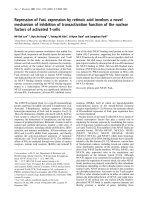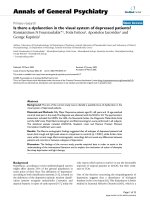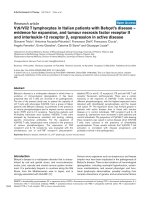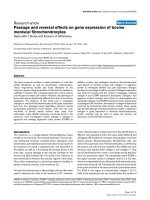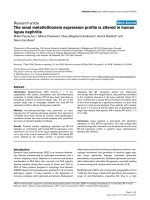Báo cáo y học: "Using surface molecule expression on lymphocytes to classify septic shock patients" ppt
Bạn đang xem bản rút gọn của tài liệu. Xem và tải ngay bản đầy đủ của tài liệu tại đây (40.45 KB, 1 trang )
Available online />Page 1 of 1
(page number not for citation purposes)
In agreement with McDunn and Hotchkiss [1], we hypothe-
sized that the simultaneous analysis of different immune
system cell subsets would improve the prediction of outcome
in septic shock patients. Abnormal redistribution of T-
lymphocyte, NK-lymphocyte and B-lymphocyte subsets has
been found to be involved in the pathogenesis of other
diseases, but the evidence reported in critical illness is less
compelling [2]. In addition to the results described in our
previous paper, and following a cytomic analysis [3], we have
also studied the predicting value for outcome of combining
different T-cell, B-cell and NK-cell markers in the 52 septic
shock patients reported in our article [4].
Receiver operating characteristic curves were built for each
phenotypic variable. The sensitivity and specificity of each
variable to predict the real outcome was thus obtained [5].
The variables with higher sensitivity values were selected and
combined to create multiple variable combinations or masks.
The mask with the highest sensitivity and specificity was
selected to predict the outcome of these patients.
According to this methodology we have found a set of five
immunophenotypic variables (CD3
+
CD8
+
CD28
+
, CD3
+
-
CD8
+
CD45RA
+
CD45RO
–
, CD19
+
CD80
+
, CD56
+
CD69
+
,
CD3
+
CD11A br
+
CD11B
+
) and their cutoff values (163, 114,
67, 114, 250 lymphocytes/μl, respectively) that are able to
improve the prediction for outcome in septic shock patients
to a sensitivity of 94% and a specificity of 100%. We
therefore conclude that the immunophenotypic study of
peripheral blood mononuclear cells is useful to predict the
outcome of septic shock patients.
Competing interests
The authors declare that they have no competing interests.
Acknowledgements
The authors would like to thank all of the medical doctors and nurses of
the intensive care unit of the Hospital Universitario Principe de Asturias
for their careful and generous collaboration while doing this work. The
present study was supported by grants S-BIO-0189/2006
MITIC/TIMEDIC from Comunidad de Madrid and 98/1431 Fondo de
Investigaciones Sanitarias, CIBERehd, and by a research prize
awarded by the Fundación Lilly.
References
1. McDunn JE, Hotchkiss RS: Leukocyte phenotyping to stratify
septic shock patients. Crit Care 2009, 13:127.
2. Annane D, Bellissant E, Cavaillon JM: Septic shock. Lancet
2005, 365:63-78.
3. Valet G: Predictive medicine by cytomics: potential and chal-
lenges. J Biol Regul Homeost Agents 2002, 16:164-167.
4. Monserrat J, de Pablo R, Reyes E, Diaz D, Barcenilla H, Zapata
MR, De la Hera A, Prieto A, Álvarez-Mon M: Clinical relevance of
the severe abnormalities of the T cell compartment in septic
shock patients. Crit Care 2009, 13:R26.
5. McNeil BJ, Hanley JA: Statistical approaches to the analysis of
receiver operating characteristic (ROC) curves. Med Decis
Making 1984, 4:137-150.
Letter
Using surface molecule expression on lymphocytes to classify
septic shock patients
Jorge Monserrat
1
, Raul de Pablo
2
, Alfredo Prieto
1
, Eduardo Reyes
1
and Melchor Álvarez-Mon
1,3
1
Laboratory of Immune System Diseases and Oncology, National Biotechnology Center–Department of Medicine (CNB-CSIC) Associated Unit,
University of Alcalá, Carretera Madrid-Barcelona, Km 33,600, Alcalá de Henares, 28871 Madrid, Spain
2
Intensive Care Unit, Hospital Universitario Príncipe de Asturias, Alcalá de Henares, 28871 Madrid, Spain
3
Immune System Diseases and Oncology Service, Hospital Universitario Príncipe de Asturias, Alcalá de Henares, 28871 Madrid, Spain
Corresponding author: Melchor Alvarez-Mon,
Published: 25 June 2009 Critical Care 2009, 13:412 (doi:10.1186/cc7919)
This article is online at />© 2009 BioMed Central Ltd
See related commentary by McDunn and Hotchkiss, and related research by Monserrat et al.,
/>NK = natural killer.

